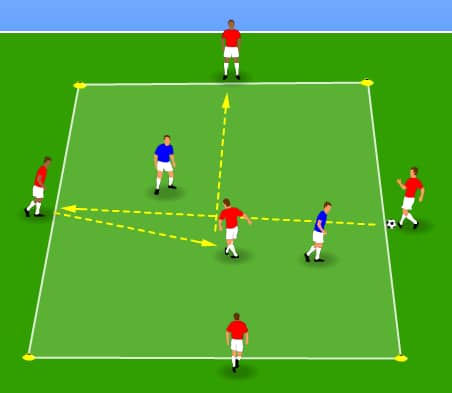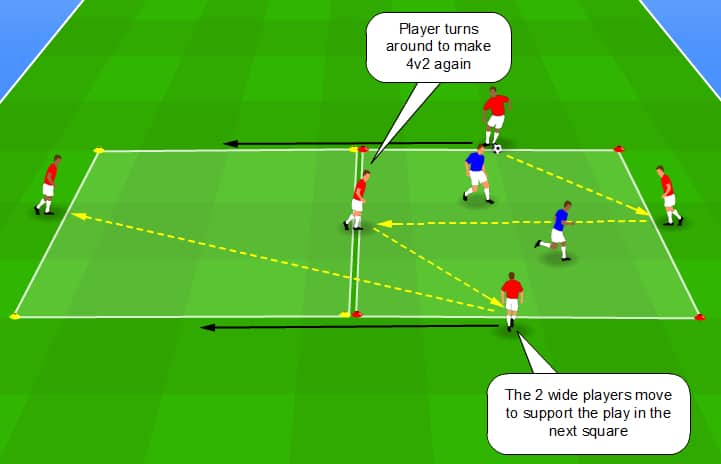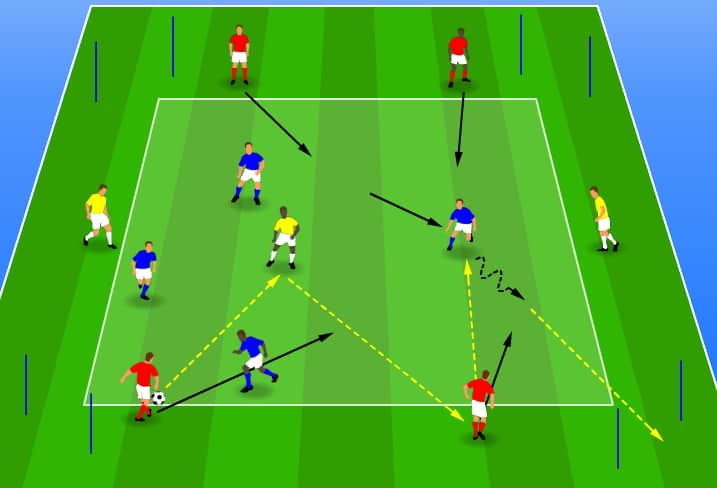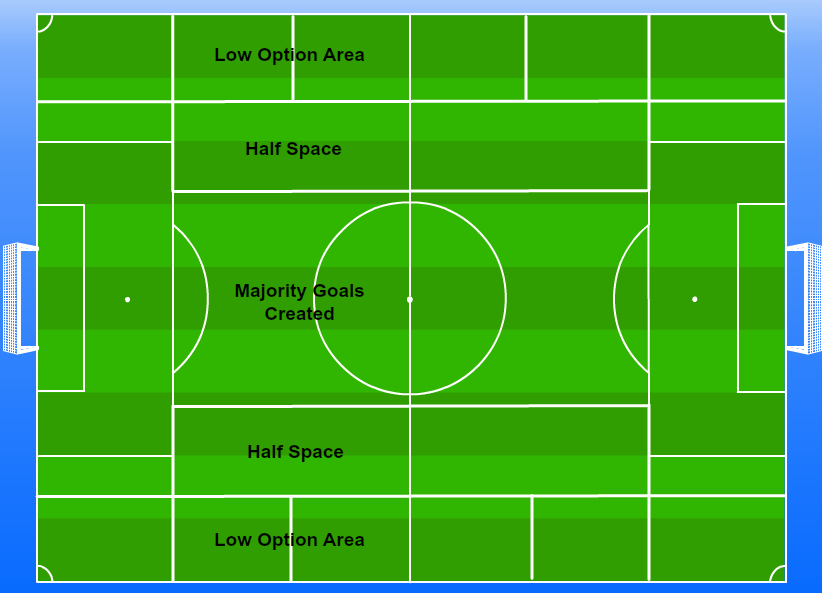Pep Guardiola is a renowned football (soccer) coach, and is known for his attacking style of football. He believes that the key to success is by controlling the game. To achieve this control, Guardiola implements what has been described as “positional play” into his team’s style of football.
The concept of positional play requires players to learn a variety of movements, shifting into and out of zones in relation to the position of:
- Teammates
- Opposition players
- The ball
This transmits into having teammates being close to the ball so that short sharp passes can be made (with purpose) which enables a team to control possession.
The explanation of what positional play is, can be quite simple and yet how to coach this concept can at times be a little daunting if you do not fully understand what positional play is.
In this blog I have created a simple guide to positional play, it’s objective and how the objective is achieved. Plus I will share tips on how to begin coaching positional play with your team, in the same way as Pep Guardiola.
Before I begin, let me break down what I will cover…
- Who invented positional play?
- Miss conception of positional play?
- The objective
- How to coach positional Play?
So let’s not waste any more time and get down to business.
Who invented positional play?

The Dutchman Rinus Michels is credited with being the first to introduce positional play, a strategy that was later implemented by Jordi Cruyff at Barcelona in what became known as Total Football.
Despite Pep Guardiola being the most famous exponent of positional play, he was not the first coach to use it in the Premier League. Michael Laudrup implemented positional play with his Swansea City team when he became coach in 2012, and went on to finish 9th in the Premier League as well as winning the League Cup.
Other coaches that use the principles of positional play include Thomas Tuchel and Hansi Flick.
Miss conception of positional play:
Positional play is not a restrictive form of playing for players. Nor is it about pointless passing just for the sake of passing.
For example, if you have a player who has an open teammate on his right side and he passes the ball to his left back instead, who only has one teammate available with the opposition having a numerical advantage on that side of the field then this should not be encouraged as it makes no sense.
It may make some people think that they are being creative, but in fact they are just wasting possession. This scenario can also create dangerous situations for your team, such as counter attacks if the ball is lost in isolated areas.
The objective
The objective of positional play is simple. To produce superiority by utilizing two main principles, which are zonal positioning and rotation. Now, in order to acquire superiority, this can be done in one of three ways:
- Numerical
- Qualitative
- Positional
Numerical superiority
This means that the team has a greater number of players in a certain area of the pitch (where the ball is) which allows the team to always have a free player. This helps the domination of possession.
An extra benefit to having a numerical superiority is the ability to counter-press to recover the ball quickly.
Qualitative
It is the aim of getting the ball to one of your more dangerous players in good attacking areas or 1v1 situations against a rival player who’s weaknesses can be exploited.
Superiority
This is the plan to get players in a position behind or between the opposition lines. This is achieved by players occupying specific zones, both horizontally and vertically.
How to coach positional play
So now we know what positional play is and it’s objectives, but how do you go about coaching your team this concept? Well, let’s have a look…
A good place to start is with rondo’s. Now I realize that the explanation of rondo’s has been done to death but the rondo exercises can involve the majority of principles that a coach is looking for from his/her team.
So let me show you a few rondos that you can use effectively…
Rondo 1
First we are going to start off with a basic rondo that I’m sure you have all set-up before (so stay with me as I go through the progressions) which is the 5v2.

5v2 situation where you can accustom your team to the short sharp passes that will be used in a game to move the opposition.
While it is a basic rondo, it is important to emphasize to the players that they must be fully focused, it is not a simple kick around solely for fun. It is a serious exercise that requires 100% concentration.
The 5th player (joker) is situated in the middle to make it more game-like, such as a central midfielder taking this spot to make wall passes.
Rondo 2
Now you can change the rondo to incorporate the switching of play. This would be utilized when the opposition has been drawn towards the ball and your team can find a player in an advantageous position, maybe a 1v1 against a weaker opponent in a totally free space in between the lines.

4v2+1 is set-up as you can see in the picture, with an extra square, and the +1 player taking the position at the end of the empty square.
The reds must make a number of passes before attempting to transfer the ball to the player available in the adjacent box. Play continues, without stopping, with the wide players moving to support the player on the ball and the 2 defenders inside the box also moving into the adjacent box to continue play.
Note: A free player (inside the square and an extra defender can be added to make a 5v3+1.
Rondo 3
With the third rondo, we can add an extra element. Transition (attacking to defending). One of the important factors of positional play is that upon losing the ball a team can counter-press due to the greater number of players within that zone.

7v4 rondo with mini goals placed in the four corners (as seen in the picture). Red team attempts to keep possession, with the 3 yellow players, whilst the blue team must quickly try and pass the ball into one of the four goals upon winning the possession.
This means that when the reds lose possession, they must quickly (along with the yellows) rush into the square and try to recover the ball before the blues are able to pass the ball into one of the goals.
As with all the rondos, they can be adapted to suit your team along with changing the number of players. One thing that I have used with my teams is to place a time limit on how long we play a rondo. For example, rondo 1 might be played for 30 seconds before the players have a few seconds rest. This ensures that there is maximum concentration due to the short period of playing time.
Bigger picture
Now we understand some of the principles of positional play through rondos, you are now ready to transfer what the players have learnt into a more game-like scenario, using half or the full pitch.
But first, let me explain how Guardiola sets-up the training pitch to help players learn and understand the positions that they must take.
The training pitch is divided by vertical and horizontal lines on the field, creating a positional grid that acts as a reference map for the players. These lines make zonal spaces such as:
- Low option area – In this area there are limited passing options and is often used to move the opposition.
- Half space – Dangerous attacking zone where probing passes can be made and shooting positions can be created (space used to find the most creative players).
Central space (majority goals created) – Here, 1 touch passing is important for this zone to be highly effective and is where the majority of goals are produced.

Rules
Whilst the idea of positional play is to move players into zones which depend on the positioning of other players and the ball, this does not make it overly restricting for the players as the rules that are used enable players to be flexible and make positional decisions for themselves by using positional play as a guide.
The rules are as follows:
- There should never be more than 3 players on the same horizontal line
- there should never be more than 2 players on the same vertical line
This means that the team needs high rotational movement.
Here is a training example that you can use:

The red team must complete 5 passes before switching the play to the opposite wide player. The objective of the short passes is to draw the opposition in to set up the attack on the other side of the pitch.
Rule 1: If the ball is on the right side, then the left winger must stay in the low option channel.
Rule 2: When the wide player has possession of the ball, a support player must occupy the half space to offer support, with a maximum of 1 other taking up a position in the same channel.
I hope this blog helped to understand positional play. Don’t forget to check out other blog post that may interest you.
